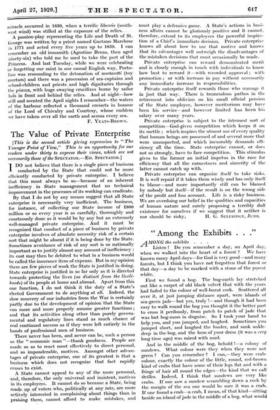St. George for England
" \TOUR saint is a strange saint, 0 Portofinesi," said a Cardinal Archbishop a few years ago, when preaching to the villagers of Portofino, where the remains of England's patron saint are now enshrined. And Lord Birkenhead once said much the same thing at the banquet of a patriotic society. Indeed, no English- man can look into the history of St. George without being a little surprised that we should have ousted good, kind King Edward the Confessor from his position, in favour of a foreign Lieutenant-Colonel in the Roman army.
Not that there is a breath of scandal about St. George.* He was certainly not that rascally bishop * A recent excellent book on the subject is St. George of England, by G. J. Marcus. (Williams and Norgate. 3s. 6d.) (With- whom GibbOn identified our hero) who sold bad pork to the army and advocated the Arian heresy and Was eventually torn to pietes by. an enraged mob. St. GeOrge the Martyr had a chapel dedicated to him while the other George was still alive. Besides, George of Cappadocia; being the bitter enemy of AthanasiuS, would Certainly not:have been sanctified by the Catholic Church, Our George was born- at Lydda, or Lud, in the roseate Vale of Sharon and seems to have been a favourite of the Eitiperof Diocletian. •- He probably -Made his-name as a- soldier in campaigns in Egypt and Persia. lie may 'even have come to England and converted to Christianity the Empress Helena, mother of .Coristantine. Some hiStOrians identify him with 'the divine Nestor," others With a monk named Helpiditis, others with the Sun God. But whoever he was and however he killed the dragon, and whichever of the various martyrdoms recorded of him was the cause of his death on April 23rd, A.D. 808, there is no doubt that seven or eight hundred years later he was a famous saint in Palestine and a particular patron Of the Crusaders.
How did his relics come to a tiny Italian seaport I do not know. Richard Coeur de Lion stopped at Portofino in the autumn of 1190 on his way to the Crusades. After his brilliant campaign and the relief of Joppa in 1192 (near St. George's birthplace) our English King was the admiration of all Christendom, and we know that he was a great upholder of the cult of St. George, rebuilding the church which had been erected at his birthplace. He would certainly not have filched the relies, which were at Lydda at the time, but he may have allowed some noble Genoese to do so—a' Doria, - Spinola,• or Fieschi. At any rate; there in Portofino, in an ebony reliquary, I have seen the thigh-bone, some ribs and an arm of our patron saint. The skull, I believe, is in Rome.'
Two and a-half centuries after the capture of Jerusalem (in 1348 to be exact) Edward III. founded the Order of the Garter, and St. George became the Saint of Chivalry and the Patron of England as he already was of Aragon and Portugal. During the fourteenth century and afterwards our soldiers always wore hiS cross on their armour. • ' Already St. George had performed iniracles for the Crusaders. He had delivered Antioch with a host mounted on pure white chargers. And at Agincourt, in the next century, "St. George for Merrie England " was our " ancient word of courage." " Thanne said the King with an high vois ' In the name of Almygte God and of Saint George, AVaunt Bailer, and Saint George this day thyn helpe.' " Our Patron came amongst our 14,000 and we defeated 50,000 French. Every spring throughout England there was-pageantry and rejoicing on St. George's Day, especially at Norwich, where the beautiful robes of the Princess and the Saint's splendid armour were much admired. Old Snap, the Dragon, was done in green wicker-Work and the boys used' to pelt it with. stones at the erid'of the day:- 'St. George's red cross was known all over the country and-his fight with the dragon was always popular, both as a play and a story.
At Portofino, too, his cult has endured and flourished: In the records of that little village it is stated that during the faniine of 1597 'San Giorgio caused two great galleys, 'laden to the gunwale with grain, to anchor in the port. In 1656, 'diming an epidemic of the Black Death, a pedlar fell down in the piazza, foaming at the mouth, and thc terrified' villagers realized that he was a bearer of the scourge. Again the saint's protection was invoked, with the result that not a single Portofinese suffered from the pestilence which ravaged Europe, killing 70,000 people in Genoa alone. In 1737, San Giorgio drove off an attack of foltrfeen Saracen sloops bent on piracy. The last miracle.occurred in 1889, when a terrific libeccio (south- west wind) was stilled at the exposure of the relics....
A passion-play representing the Life and Death of St. George was written by a priest named Gaetano Marchese in 1771 and acted every five years up to 1859. I can remember an old ironsmith (Agostino Bensa, then aged ninety-six) who told me he used to take the part of the Princess. And last Tuesday, while we were celebrating or forgetting our saint in our casual English way, Porto- fino was resounding to the detonation of mortaretti (toy mortars) and there was a procession of sea-captains and school-children and priests and high dignitaries through the piazza, with huge swaying crucifixes borne by sailor lads in front and behind the relics. And at night—how still and scented the April nights I remember—the waters of the harbour reflected a thousand cressets in honour of the Lord of Chivalry and Courtesy, whose emblem we have taken over all the earth and across every sea.
F. YEATS-BROWN.









































 Previous page
Previous page